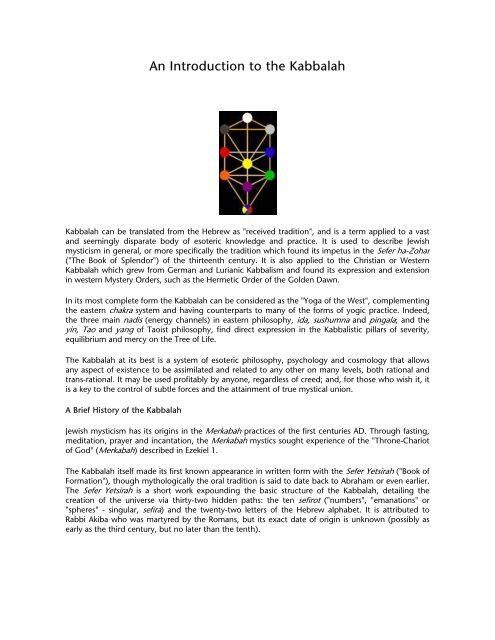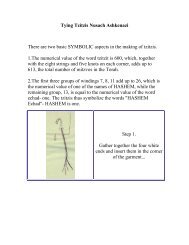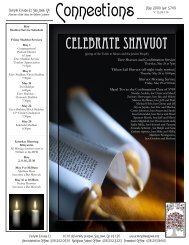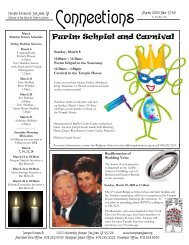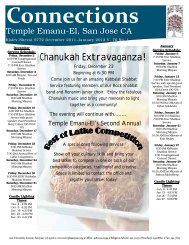An Introduction to the Kabbalah - Temple Emanu-El
An Introduction to the Kabbalah - Temple Emanu-El
An Introduction to the Kabbalah - Temple Emanu-El
Create successful ePaper yourself
Turn your PDF publications into a flip-book with our unique Google optimized e-Paper software.
<strong>An</strong> <strong>Introduction</strong> <strong>to</strong> <strong>the</strong> <strong>Kabbalah</strong><br />
<strong>Kabbalah</strong> can be translated from <strong>the</strong> Hebrew as "received tradition", and is a term applied <strong>to</strong> a vast<br />
and seemingly disparate body of esoteric knowledge and practice. It is used <strong>to</strong> describe Jewish<br />
mysticism in general, or more specifically <strong>the</strong> tradition which found its impetus in <strong>the</strong> Sefer ha-Zohar<br />
("The Book of Splendor") of <strong>the</strong> thirteenth century. It is also applied <strong>to</strong> <strong>the</strong> Christian or Western<br />
<strong>Kabbalah</strong> which grew from German and Lurianic Kabbalism and found its expression and extension<br />
in western Mystery Orders, such as <strong>the</strong> Hermetic Order of <strong>the</strong> Golden Dawn.<br />
In its most complete form <strong>the</strong> <strong>Kabbalah</strong> can be considered as <strong>the</strong> "Yoga of <strong>the</strong> West", complementing<br />
<strong>the</strong> eastern chakra system and having counterparts <strong>to</strong> many of <strong>the</strong> forms of yogic practice. Indeed,<br />
<strong>the</strong> three main nadis (energy channels) in eastern philosophy, ida, sushumna and pingala; and <strong>the</strong><br />
yin, Tao and yang of Taoist philosophy, find direct expression in <strong>the</strong> Kabbalistic pillars of severity,<br />
equilibrium and mercy on <strong>the</strong> Tree of Life.<br />
The <strong>Kabbalah</strong> at its best is a system of esoteric philosophy, psychology and cosmology that allows<br />
any aspect of existence <strong>to</strong> be assimilated and related <strong>to</strong> any o<strong>the</strong>r on many levels, both rational and<br />
trans-rational. It may be used profitably by anyone, regardless of creed; and, for those who wish it, it<br />
is a key <strong>to</strong> <strong>the</strong> control of subtle forces and <strong>the</strong> attainment of true mystical union.<br />
A Brief His<strong>to</strong>ry of <strong>the</strong> <strong>Kabbalah</strong><br />
Jewish mysticism has its origins in <strong>the</strong> Merkabah practices of <strong>the</strong> first centuries AD. Through fasting,<br />
meditation, prayer and incantation, <strong>the</strong> Merkabah mystics sought experience of <strong>the</strong> "Throne-Chariot<br />
of God" (Merkabah) described in Ezekiel 1.<br />
The <strong>Kabbalah</strong> itself made its first known appearance in written form with <strong>the</strong> Sefer Yetsirah ("Book of<br />
Formation"), though mythologically <strong>the</strong> oral tradition is said <strong>to</strong> date back <strong>to</strong> Abraham or even earlier.<br />
The Sefer Yetsirah is a short work expounding <strong>the</strong> basic structure of <strong>the</strong> <strong>Kabbalah</strong>, detailing <strong>the</strong><br />
creation of <strong>the</strong> universe via thirty-two hidden paths: <strong>the</strong> ten sefirot ("numbers", "emanations" or<br />
"spheres" - singular, sefira) and <strong>the</strong> twenty-two letters of <strong>the</strong> Hebrew alphabet. It is attributed <strong>to</strong><br />
Rabbi Akiba who was martyred by <strong>the</strong> Romans, but its exact date of origin is unknown (possibly as<br />
early as <strong>the</strong> third century, but no later than <strong>the</strong> tenth).
What was <strong>to</strong> become known as German Kabbalism or Early Hasidism began in Italy in 917 with Aaron<br />
ben Samuel. This had its roots in Merkabah mysticism, involving magical rituals, meditation, prayer<br />
and ecstatic experience. Its emphasis on <strong>the</strong> magical power of words fuelled <strong>the</strong> development of <strong>the</strong><br />
Kabbalistic techniques of gematria (<strong>the</strong> study of <strong>the</strong> numerical values of letters and words), notarikon<br />
(<strong>the</strong> study of <strong>the</strong> first and last letters of words) and temurah (<strong>the</strong> study of <strong>the</strong> permutation and<br />
combination of letters).<br />
The pre-eminent form of Jewish mysticism, sometimes referred <strong>to</strong> as Classical <strong>Kabbalah</strong>, began in<br />
Provence, France, in <strong>the</strong> thirteenth century, but flourished most readily in mediaeval Spain. It<br />
contains elements of both Gnosticism and Neo-pla<strong>to</strong>nism, and is more concerned with <strong>the</strong> nature<br />
and structure of all creation from <strong>the</strong> divine <strong>to</strong> <strong>the</strong> material worlds, than with ecstatic experience.<br />
The most important work of this period is <strong>the</strong> Zohar (Sefer ha-Zohar or "Book of Splendor"), written<br />
between 1280 and 1286 by <strong>the</strong> Spanish Kabbalist Moses de Leon (1250-1305), though attributed <strong>to</strong><br />
a second century rabbi, Simeon bar Yohai. This deals with <strong>the</strong> ten sefirot emanating from <strong>the</strong><br />
ineffable infinite (en sof) through which <strong>the</strong> universe is created and maintained. The mutual<br />
interaction of <strong>the</strong>se sefirot and <strong>the</strong>ir individual natures are seen both as expressing <strong>the</strong> nature of<br />
divinity and as archetypes for all of creation. The Bahir ("Book of Illumination") is <strong>the</strong> third important<br />
Kabbalistic text, appearing in France around <strong>the</strong> eleventh century.<br />
The expulsion of Jews from Spain in 1492 served <strong>to</strong> spread <strong>the</strong> Spanish <strong>Kabbalah</strong> fur<strong>the</strong>r in<strong>to</strong> Europe.<br />
The next major development occurred with <strong>the</strong> advent of Lurianic <strong>Kabbalah</strong>, named after its<br />
origina<strong>to</strong>r, Isaac Luria Ashkenazi (1534-1572). In this, <strong>the</strong> en sof contracts (tsimtsum) at <strong>the</strong> start of<br />
creation <strong>to</strong> allow "room" for cosmic expansion. This also allows "room" for evil, <strong>the</strong> qelippot (literally<br />
"shells", singular qelippa) in which sparks of <strong>the</strong> divine light become entrapped after a shattering of<br />
<strong>the</strong> divine receptacles during emanation. Thus freedom of choice is born of <strong>the</strong> godhead's selfinflicted<br />
suffering, and <strong>the</strong> redemption (tiqqun) of <strong>the</strong> broken world and <strong>the</strong> reunification of divinity<br />
becomes <strong>the</strong> overriding goal of humanity. The exile of all human beings is symbolized in <strong>the</strong> exile of<br />
Israel, and <strong>the</strong> tiqqun is paralleled in Israel's task <strong>to</strong> "ga<strong>the</strong>r what has been scattered", symbolizing <strong>the</strong><br />
redemption of <strong>the</strong> world, crowned with <strong>the</strong> coming of <strong>the</strong> Messiah.<br />
This move <strong>to</strong>wards a messianic philosophy fostered <strong>the</strong> Hasidic movement which made <strong>the</strong> <strong>Kabbalah</strong><br />
more widely accessible. The most important figure here was Israel ben <strong>El</strong>eazar (1698-1760), known<br />
as <strong>the</strong> Baal Shem Tov, <strong>the</strong> "Master of <strong>the</strong> Holy Name".<br />
Western or Christian Kabbalism grew from German and <strong>the</strong>n Lurianic Kabbalism. Mediaeval<br />
ceremonial magicians were fond of appropriating Kabbalistic words of power, and in <strong>the</strong> late<br />
fifteenth and sixteenth centuries, western Kabbalists augmented <strong>the</strong> <strong>Kabbalah</strong> with aspects of<br />
Christian <strong>the</strong>ology and alchemy. The <strong>Kabbalah</strong> was included in Agrippa von Nettesheim's (1486-<br />
1535) key work, De Occulta Philosophia Libri Tres (1531).<br />
The nineteenth and twentieth centuries have seen fur<strong>the</strong>r development of <strong>the</strong> Western <strong>Kabbalah</strong><br />
from occultists such as <strong>El</strong>iphas Levi, Papus (1865-1916) and members of <strong>the</strong> Hermetic Order of <strong>the</strong><br />
Golden Dawn such as Aleister Crowley and Dion Fortune (1890-1946). Links between <strong>the</strong> <strong>Kabbalah</strong><br />
and many o<strong>the</strong>r philosophical, mythological and religious systems have been postulated and<br />
detailed; <strong>the</strong> most important being <strong>the</strong> links between <strong>the</strong> <strong>Kabbalah</strong>, astrology and <strong>the</strong> Tarot.
The Tree of Life<br />
Central <strong>to</strong> modern Kabbalistic study is <strong>the</strong> diagram Otz Chiim, <strong>the</strong> Tree of Life. This is a<br />
representation of <strong>the</strong> thirty-two "paths" comprised of <strong>the</strong> ten sefirot and <strong>the</strong> twenty-two paths<br />
through which <strong>the</strong>y interrelate (introduced in our <strong>Introduction</strong> <strong>to</strong> <strong>the</strong> <strong>Kabbalah</strong>). Though <strong>the</strong> tree<br />
may be drawn with variations in <strong>the</strong> location of paths - particularly in pure, Judaic <strong>Kabbalah</strong> - esoteric<br />
tradition is consistent in presenting <strong>the</strong> tree as above, with <strong>the</strong> paths in <strong>the</strong> positions shown.<br />
The Tree of Life describes <strong>the</strong> descent of <strong>the</strong> divine in<strong>to</strong> <strong>the</strong> manifest world, and methods by which<br />
divine union may be attained in this life. It can be viewed as a map of <strong>the</strong> human psyche, and of <strong>the</strong><br />
workings of creation, both manifest and unmanifest. Indeed, any system can be more fully<br />
unders<strong>to</strong>od both in itself and relative <strong>to</strong> any o<strong>the</strong>r system by viewing it in relation <strong>to</strong> <strong>the</strong> Tree. The<br />
Tree allows and requires a more holistic understanding of any <strong>to</strong>pic <strong>to</strong> which it is applied - reason,<br />
spiritual perception and intuition are all needed, as is clear from <strong>the</strong> structure of <strong>the</strong> Tree itself.<br />
It is important <strong>to</strong> realize that <strong>the</strong> pure nature of divinity is unity, and that <strong>the</strong> seemingly separate<br />
aspects or emanations exist only in view of <strong>the</strong> emanated, living in a state of illusory separation. This<br />
is expressed in <strong>the</strong> Zohar: "in creating this world below, <strong>the</strong> world above lost nothing. It is <strong>the</strong> same<br />
for each sefira: if one is illuminated, <strong>the</strong> next loses none of its brilliance". The absolute divine light can<br />
be said <strong>to</strong> be refracted through <strong>the</strong> prism of <strong>the</strong> sefirot in<strong>to</strong> <strong>the</strong> apparently multifarious world of<br />
creation.
The Tree may be viewed in many different ways by grouping <strong>the</strong> sefirot <strong>to</strong>ge<strong>the</strong>r depending on<br />
circumstance. The most important views are <strong>the</strong> three pillars of severity (sefirot 3, 5 and 8),<br />
equilibrium (sefirot 1, 6, 9 and 10) and mercy (sefirot 2, 4 and 7); and <strong>the</strong> three major triangles: <strong>the</strong><br />
supernal triangle (sefirot 1, 2 and 3), <strong>the</strong> ethical triangle (sefirot 4, 5 and 6) and <strong>the</strong> astral triangle<br />
(sefirot 7, 8 and 9). Also worthy of note are <strong>the</strong> seven planes of <strong>the</strong> tree and <strong>the</strong> correspondence<br />
between <strong>the</strong> sefirot and <strong>the</strong> chakras of eastern mysticism.<br />
The Structure of <strong>the</strong> Tree<br />
The names and numbers of <strong>the</strong> ten sefirot are given in order below. The most usual name for each<br />
sefira is given first, followed by some alternatives.<br />
1 Ke<strong>the</strong>r (Crown) or Ke<strong>the</strong>r <strong>El</strong>yon (Supreme Crown)<br />
2 Chokmah (Wisdom)<br />
3 Binah (Understanding or Intelligence)<br />
4 Chesed (Mercy or Grace) or Gedullah (Greatness)<br />
5 Geburah (Severity or Power), Din (Judgement) or Pahad (Fear)<br />
6 Tifereth (Beauty) or Rahamim (Mercy)<br />
7 Netsach (Vic<strong>to</strong>ry or Constancy)<br />
8 Hod (Glory or Majesty)<br />
9 Yesod (Foundation) or Tsedek (Justice)<br />
10 Malkuth (Kingdom) or Shekhinah (Divine Immanence)<br />
In viewing <strong>the</strong> Tree as comprised of <strong>the</strong> three pillars of severity, equilibrium (or mildness) and mercy,<br />
each sefira can be classed as ei<strong>the</strong>r negative (restrictive, passive and destructive), balancing, or<br />
positive (expansive, active and constructive) depending upon whe<strong>the</strong>r it lies on <strong>the</strong> pillar of severity,<br />
equilibrium or mercy respectively. It is important <strong>to</strong> realize that no value judgement is implied in <strong>the</strong><br />
terms 'positive or masculine' and 'negative or feminine'; each is nei<strong>the</strong>r better nor worse than <strong>the</strong><br />
o<strong>the</strong>r. Indeed, it can be said that evil is a synonym for imbalance, highlighting <strong>the</strong> vital,<br />
complementary natures of <strong>the</strong> pillars.<br />
Each sefira in itself has a dual aspect of negative and positive: namely, it is negative or receptive in<br />
relation <strong>to</strong> <strong>the</strong> preceding sefira and positive or transmissive in relation <strong>to</strong> <strong>the</strong> succeeding sefira. So, for<br />
example, Tifereth is negative <strong>to</strong> Geburah and positive <strong>to</strong> Netsach. This has <strong>the</strong> consequence that,<br />
taking <strong>the</strong> Tree in isolation, Ke<strong>the</strong>r may be considered as entirely positive (masculine) and Malkuth<br />
entirely negative (feminine), in that <strong>the</strong>y have no preceding or succeeding sefira respectively.<br />
However, as will be seen from <strong>the</strong> discussion of <strong>the</strong> Four Worlds below, "Malkuth in one world is<br />
Ke<strong>the</strong>r of <strong>the</strong> next": even <strong>the</strong>se sefirot can be viewed in <strong>the</strong>ir dual aspect.
O<strong>the</strong>r positive-negative relationships of <strong>the</strong> sefirot may be considered <strong>to</strong>o. For example, sefirot in <strong>the</strong><br />
same pillar can be viewed in relation <strong>to</strong> each o<strong>the</strong>r. Thus Chesed may be seen as negative <strong>to</strong><br />
Chokmah and positive <strong>to</strong> Netsach. Sefirot on <strong>the</strong> middle pillar also have a strong sense of balance,<br />
each being a balance or resolving point of one or more of <strong>the</strong> three dualities (Chokmah-Binah,<br />
Chesed-Geburah, and Netsach-Hod) found between <strong>the</strong> outer pillars.<br />
Before leaving <strong>the</strong> pillars, let us reiterate <strong>the</strong>ir use as a means <strong>to</strong> syn<strong>the</strong>size <strong>the</strong> <strong>Kabbalah</strong> with<br />
threefold systems. Examples of analogies between <strong>the</strong> pillars of severity, equilibrium and mercy and<br />
o<strong>the</strong>r trinities include Taoist concepts (yin, Tao and yang); tantric energy channels (ida, sushumna<br />
and pingala); Hindu (Shiva, Brahma and Vishnu) and Christian (Holy Spirit, Fa<strong>the</strong>r and Son) trinities;<br />
alchemical concepts (Sulfur, Mercury and Salt); aspects of <strong>the</strong> Goddess (Crone, Mo<strong>the</strong>r and Maiden);<br />
phases of <strong>the</strong> moon (waning, full and waxing); and <strong>the</strong> Hebrew "Mo<strong>the</strong>r" letters (Mem, Aleph and<br />
Shin). Knowledge of any of <strong>the</strong>se can help enrich your knowledge of <strong>the</strong> <strong>Kabbalah</strong> through<br />
association with <strong>the</strong> Tree, and vice versa. This method of analogy can be applied <strong>to</strong> each sefira<br />
individually, <strong>to</strong> <strong>the</strong> pillars or triangles of <strong>the</strong> Tree, <strong>to</strong> <strong>the</strong> planes, <strong>the</strong> Worlds or any o<strong>the</strong>r way <strong>the</strong> Tree<br />
can be conceived. The balance of structure and flexibility in <strong>the</strong> Tree gives it its great strength as a<br />
means of assimilation, understanding and interconnectivity.<br />
One final attribution of <strong>the</strong> pillars that is well worth reflecting upon is that of <strong>the</strong> three precepts <strong>to</strong><br />
Enlightenment, which can correspond <strong>to</strong> <strong>the</strong> pillars of severity, mercy and mildness respectively: Selfcontrol,<br />
Self-knowledge and Self-realization.<br />
Da'ath<br />
In addition <strong>to</strong> <strong>the</strong> ten sefirot, <strong>the</strong> diagram of <strong>the</strong> Tree of Life above shows <strong>the</strong> dark and unlabeled<br />
"sefira which is not a sefira", Da'ath. This "sefira" has no number and no position on <strong>the</strong> Tree in<br />
relation <strong>to</strong> <strong>the</strong> o<strong>the</strong>r sefirot, though when it is shown it is located centrally in <strong>the</strong> Abyss (between <strong>the</strong><br />
planes of Binah-Chokmah and Geburah-Chesed) with no explicit connection <strong>to</strong> any o<strong>the</strong>r sefira.<br />
Da'ath is Knowledge, and is sometimes considered as being an expression of Binah and Chokmah<br />
combined. It is a place of balanced power.<br />
The Four Worlds<br />
The sefirot, introduced in our discussion of <strong>the</strong> Tree of Life, can usefully be considered on <strong>the</strong>ir own,<br />
but Kabbalists fur<strong>the</strong>r refine <strong>the</strong> system by viewing <strong>the</strong>m as acting on or through four different levels<br />
or worlds which form a hierarchy of <strong>the</strong>ir own. Just as from Ke<strong>the</strong>r <strong>to</strong> Malkuth <strong>the</strong>re is a successive<br />
movement from <strong>the</strong> abstract <strong>to</strong> <strong>the</strong> manifest, so <strong>the</strong>re is in <strong>the</strong> Kabbalistic worlds from Atziluth <strong>to</strong><br />
Assiah:
Atziluth Archetypal World (World of Emanations) or Divine World<br />
Briah Creative World or World of Thrones<br />
Yetsirah Formative World<br />
Assiah Manifest World<br />
These four worlds can be considered as a linear hierarchy, each containing its own full Tree, in which<br />
Malkuth in one world becomes Ke<strong>the</strong>r of <strong>the</strong> world below, and Ke<strong>the</strong>r of one world becomes<br />
Malkuth of <strong>the</strong> world above. Malkuth is seen as <strong>the</strong> complementary fulfillment of Ke<strong>the</strong>r: <strong>the</strong> first is<br />
Divine Immanence, <strong>the</strong> latter Divine Transcendence.<br />
<strong>An</strong> alternative is <strong>to</strong> view <strong>the</strong> four worlds as being expressed through a single Tree. Atziluth is<br />
expressed through <strong>the</strong> sefira Ke<strong>the</strong>r; Briah through Chokmah and Binah; Yetsirah through <strong>the</strong> six<br />
sefirot Chesed <strong>to</strong> Yesod; and Assiah through Malkuth. (Some prefer <strong>to</strong> view Atziluth as acting<br />
through both Ke<strong>the</strong>r and Chokmah, and Briah as acting through Binah alone.)<br />
Both systems of ei<strong>the</strong>r one or four Trees are equally valid and are used according <strong>to</strong> context, ra<strong>the</strong>r<br />
like <strong>the</strong> physicist viewing light as a wave of energy or a stream of particles depending on<br />
circumstance. A fur<strong>the</strong>r outlook is that each sefira can be viewed as a whole Tree itself, giving ten<br />
Trees and one hundred sefirot. Kabbalistically <strong>the</strong>se numbers can be considered equivalent as, using<br />
techniques similar <strong>to</strong> numerology, 100, 10 and 1 are fundamentally one (1+0+0 = 1+0 = 1).<br />
The fourfold aspect given <strong>to</strong> each sefira by its existence in each of <strong>the</strong> four worlds allows application<br />
of <strong>the</strong> <strong>Kabbalah</strong> <strong>to</strong> fourfold systems such as <strong>the</strong> western elements (Fire, Air, Water and Earth), <strong>the</strong><br />
letters of <strong>the</strong> Tetragramma<strong>to</strong>n (Hebrew Name of God: Yod, He, Vau, final He), <strong>the</strong> Jungian functions<br />
and <strong>the</strong> Minor Arcana of <strong>the</strong> Tarot. The latter is very important in <strong>the</strong> Western <strong>Kabbalah</strong>: each of <strong>the</strong><br />
four Tarot suits contains precisely ten numbered cards (as do our modern playing cards which are<br />
derived from <strong>the</strong> Tarot), and so a Tarot deck contains a representation of <strong>the</strong> Tree in each of four<br />
worlds. The four court cards in each suit offer a fur<strong>the</strong>r fourfold correspondence, and each of <strong>the</strong><br />
twenty-two Major Arcana cards corresponds <strong>to</strong> one of <strong>the</strong> twenty-two letters of <strong>the</strong> Hebrew alphabet,<br />
and <strong>to</strong> one of <strong>the</strong> twenty-two paths joining <strong>the</strong> sefirot on <strong>the</strong> Tree of Life.<br />
For use in prayer, meditation or magic, each sefira is assigned a Name of God <strong>to</strong> represent its essence<br />
in Atziluth, an Archangel for Briah, an <strong>An</strong>gelic Host for Yetsirah, and a Mundane Chakra (generally<br />
expressed through planetary forces) for Assiah.<br />
Sefira Divine Name Archangel <strong>An</strong>gelic Host Mundane Chakra<br />
Ke<strong>the</strong>r Eheieh<br />
("I am")<br />
Chokmah Yah<br />
("Lord")<br />
Binah Yhvh <strong>El</strong>ohim<br />
("Lord God")<br />
Chesed <strong>El</strong><br />
("God")<br />
Geburah <strong>El</strong>ohim Gibor<br />
("Almighty God")<br />
Metatron Chioth Ha Qodesh Rashith ha-Gilgalim,<br />
Primum Mobile<br />
Ratziel Auphanium Mazloth,<br />
Zodiac<br />
Tzaphkiel Aralim Shabbathai,<br />
Saturn<br />
Tzadkiel Chasmalim Tzedek,<br />
Jupiter<br />
Khamael Seraphim Madim,<br />
Mars
Tifereth Yhvh <strong>El</strong>oah ve-Daath Mikael Malakim Shemesh,<br />
("Lord God of Knowledge")<br />
Sun<br />
Netsach Yhvh Tzabaoth<br />
("Lord of Hosts")<br />
Hod <strong>El</strong>ohim Tzaboath<br />
("God of Hosts")<br />
Yesod Shaddai <strong>El</strong> Chai<br />
("Almighty Living God")<br />
Malkuth Adonai ha-Aretz<br />
("Lord of Earth")<br />
Auriel <strong>El</strong>ohim Nogah,<br />
Venus<br />
Raphael Beni <strong>El</strong>ohim Kokab,<br />
Mercury<br />
Gabriel Ashim Levanah,<br />
Moon<br />
Sandalphon Kerubim Cholam Yesodoth,<br />
<strong>El</strong>ements<br />
The Qelippot<br />
Each sefira, introduced in our discussion of <strong>the</strong> Tree of Life, has its unbalanced aspect; and <strong>the</strong>se are<br />
said <strong>to</strong> form <strong>the</strong> infernal tree of <strong>the</strong> qelippot ("harlots" or "shells" - singular, qelippa). This tree may be<br />
viewed as growing down from Malkuth of Assiah (see <strong>the</strong> discussion of <strong>the</strong> Four Worlds) in an<br />
inversion of <strong>the</strong> Divine Tree. Thus <strong>the</strong> unbalanced qelippa corresponding <strong>to</strong> Malkuth stands above<br />
that which corresponds <strong>to</strong> Ke<strong>the</strong>r - matter as master of spirit, an inversion of <strong>the</strong> natural order of<br />
Creation.<br />
The qelippotic equivalent of <strong>the</strong> supernal triad, Ke<strong>the</strong>r, Chokmah and Binah, consists of Tohu (<strong>the</strong><br />
Formless), Bohu (<strong>the</strong> Void) and Chashek (<strong>the</strong> Darkness) respectively. The remaining seven qelippot<br />
correspond <strong>to</strong> seven hells. On <strong>the</strong> plane of Atziluth, <strong>the</strong> qelippot have no influence, and so <strong>the</strong>re is no<br />
qelippotic equivalent of <strong>the</strong> Name of God. There is, however, qelippotic influence in <strong>the</strong> three lower<br />
worlds. In Briah, <strong>the</strong> Archangel of each sefira has a corresponding Devil of <strong>the</strong> qelippa; in Yetsirah<br />
each <strong>An</strong>gelic Host is matched by a Cohort of Demons; and in Assiah each Mundane Chakra has a<br />
corresponding Infernal Habitation.<br />
It is important <strong>to</strong> make <strong>the</strong> distinction between true and apparent evil. Geburah may be considered<br />
"evil" in its cruel, destructive aspects; but <strong>the</strong> true essence of Geburah is vital as a balance <strong>to</strong> <strong>the</strong><br />
o<strong>the</strong>rwise wan<strong>to</strong>n inclusiveness of Chesed. It is an error <strong>to</strong> view one half of a dynamic duality as<br />
"good" and <strong>the</strong> o<strong>the</strong>r "evil": both are necessary for balance, <strong>to</strong> prevent <strong>the</strong> true evil of imbalance. It is<br />
precisely <strong>the</strong> unbalanced aspects of each sefira that are <strong>to</strong> be found in <strong>the</strong> qelippot. The qelippotic<br />
equivalent of Geburah really is pure destructive cruelty, not as a balance <strong>to</strong> anything else, but solely<br />
for its own sake. Thus <strong>the</strong> qelippot represent true, active evil, and it is part of <strong>the</strong> Great Work <strong>to</strong><br />
neutralize such forces, not by suppression or subjugation, but by bringing <strong>the</strong>m in<strong>to</strong> balance as<br />
aspects of <strong>the</strong>ir corresponding sefirot.<br />
One way of considering <strong>the</strong> formation of <strong>the</strong> qelippot is <strong>to</strong> see <strong>the</strong>m as a direct consequence of <strong>the</strong><br />
"Lightning Flash of Creation" in which <strong>the</strong> sefirot were emanated in order, one from <strong>the</strong> o<strong>the</strong>r, from<br />
Ke<strong>the</strong>r down <strong>to</strong> its fulfillment in Malkuth. At <strong>the</strong> formation of one sefira, and before <strong>the</strong> subsequent<br />
emanation of its successor, that sefira was in a sense unbalanced. For example, with Chokmah<br />
formed but not having yet emanated its balancing successor Binah, this unbalanced state of<br />
Chokmah created a pattern around which <strong>the</strong> qelippa Bohu could later crystallize.<br />
Finally, it is worth noting briefly that <strong>the</strong> qelippot can also be viewed as being accessed through <strong>the</strong><br />
"sefira which is not a sefira", Da'ath. This "sefira" has no number and no position on <strong>the</strong> Tree in<br />
relation <strong>to</strong> <strong>the</strong> o<strong>the</strong>r sefirot, though when it is shown it is located centrally in <strong>the</strong> Abyss (between <strong>the</strong><br />
planes of Binah-Chokmah and Geburah-Chesed) and with no explicit connection <strong>to</strong> any o<strong>the</strong>r sefira.
Da'ath is Knowledge, but consider <strong>the</strong> use of Knowledge without Understanding<br />
(Binah).<br />
The Negative Veils<br />
The major problem that Mystics of all eras have come up against in trying <strong>to</strong> express<br />
<strong>the</strong>ir transcendental experiences <strong>to</strong> o<strong>the</strong>rs is that <strong>the</strong>se experiences lie beyond <strong>the</strong><br />
bounds of <strong>the</strong> rational (and even intuitional) mind on which human written and<br />
verbal communication is based. Many methods have been tried, including allegory, antinomy, poetry<br />
and mundane approximation; but all founder on <strong>the</strong> fact that transcendental experience cannot be<br />
adequately conveyed through sub-transcendental means of communication.<br />
In Kabbalism, this problem occurs especially in discussions of <strong>the</strong> higher sefirot on <strong>the</strong> Tree of Life,<br />
and becomes insurmountable in discussing that which lies beyond or above <strong>the</strong> Tree. The manifest<br />
Tree expressed through <strong>the</strong> sefirot in <strong>the</strong> four worlds is as much as can usefully be conveyed <strong>to</strong> <strong>the</strong><br />
human mind through language; and beyond this, beyond Ke<strong>the</strong>r of Atziluth, are drawn <strong>the</strong> Three<br />
Veils of Negative Existence: en (Nothing), en sof (Limitless Nothing), and en sof or (Limitless Light).<br />
(Atziluth itself, and even Briah, are really beyond human conception, <strong>the</strong>ir "structure" being hinted at<br />
through <strong>the</strong> tangible expressions of <strong>the</strong> sefirot in <strong>the</strong> lower worlds.)<br />
The very epi<strong>the</strong>ts "veil" and "negative existence" serve <strong>to</strong> remind us that what <strong>the</strong> Veils represent<br />
cannot be conceived of by <strong>the</strong> human mind, let alone expressed in words. The Veils thus serve as a<br />
backdrop in front of which we can see more clearly that which it is possible for our minds <strong>to</strong><br />
apprehend, and as a goal for us <strong>to</strong> reach for and beyond at a later stage in our personal or collective<br />
evolution.<br />
The Veils contain and conceal <strong>the</strong> unmanifest aspects of <strong>the</strong> sefirot, i.e. precisely those aspects which<br />
<strong>the</strong> human mind cannot comprehend. They are considered as depending back from Ke<strong>the</strong>r, or as<br />
aspects of Ke<strong>the</strong>r itself, which is brought in<strong>to</strong> being by <strong>the</strong> concentration of <strong>the</strong> en sof or. Thus we<br />
can see <strong>the</strong> meaning of <strong>the</strong> important aphorism: "Ke<strong>the</strong>r is <strong>the</strong> Malkuth of <strong>the</strong> Unmanifest". So while<br />
Ke<strong>the</strong>r is "<strong>the</strong> First Cause" in <strong>the</strong> sense of being <strong>the</strong> first comprehensible point of manifestation, its<br />
cause is unknowable within <strong>the</strong> confines of <strong>the</strong> human mind (though this does not mean that it is<br />
absolutely unknowable) and this is expressed through <strong>the</strong> Veils. Though <strong>the</strong>ir appellations are<br />
meaningless, <strong>the</strong>y are none<strong>the</strong>less carefully chosen <strong>to</strong> be redolent of that which <strong>the</strong>y represent. Thus,<br />
<strong>the</strong> statement that Ke<strong>the</strong>r is manifested through <strong>the</strong> focusing of <strong>the</strong> en sof or is meaningless in itself,<br />
but can convey a shadow of its mystery <strong>to</strong> our transcendental selves.<br />
Fur<strong>the</strong>r Notes on <strong>the</strong> Veils<br />
The first sefira, Ke<strong>the</strong>r, is <strong>the</strong> uncreated and all-encompassing "point" of actionless unity which is both<br />
transcendent and immanent in its evanescent reflection: <strong>the</strong> Creation. The immanence of Ke<strong>the</strong>r is<br />
experienced in progressively more diluted forms in <strong>the</strong> remainder of <strong>the</strong> sefirot; its transcendence is<br />
found in <strong>the</strong> three Veils of Negative Existence which are generally considered as lying back from unity<br />
ra<strong>the</strong>r than being separate from it. Thus <strong>the</strong> same terms are often applied <strong>to</strong> ei<strong>the</strong>r <strong>the</strong> Unity or <strong>the</strong><br />
Veils: "The Concealed of <strong>the</strong> Concealed", etc.
Negative Existence is, by its very essence, beyond definition; and <strong>the</strong> fact that <strong>the</strong>re is considered <strong>to</strong><br />
be a triad of Negative Veils should not detract from <strong>the</strong>ir essential unity: <strong>the</strong> three-fold process is a<br />
fundamental precept of so many occult systems. The triadic unity of <strong>the</strong> Negative Veils foreshadows<br />
<strong>the</strong> triadic unity of <strong>the</strong> Supernals. The three Veils may also be named as below, and are sometimes<br />
numbered 0, 00 and 000 respectively:<br />
AIN (Ain) Nothingness 0<br />
AIN SVP (Ain Soph) The Limitless 00<br />
AIN SVP AVR (Ain Soph Aur) The Limitless Light 000<br />
These Veils can be considered <strong>to</strong> hold <strong>the</strong> transcendent aspects of <strong>the</strong> manifest sefirot, and as <strong>the</strong><br />
Veils are focused on Ke<strong>the</strong>r, <strong>the</strong> first sefira can be thought of as <strong>the</strong> Malkuth of <strong>the</strong> transcendent tree.<br />
The word AIN consists of three letters, and <strong>the</strong> corresponding first veil foreshadows <strong>the</strong> first three<br />
sefirot in <strong>the</strong>ir hidden ideas. In <strong>the</strong> same way, <strong>the</strong> second and third veils foreshadow <strong>the</strong> first six and<br />
<strong>the</strong> first nine sefirot respectively. Now nine is considered <strong>to</strong> be a number of completion, beyond<br />
which progression is only possible by a return <strong>to</strong> unity, but on a different level. This is easily seen in<br />
<strong>the</strong> number ten's usual representation in Arabic numerals, where <strong>the</strong> circle 0 represents <strong>the</strong> Negative<br />
from which <strong>the</strong> Unity 1 is newly derived. Thus <strong>the</strong> Limitless Light of Negativity, while not having an<br />
origin in a point, does have a focus in <strong>the</strong> number one of <strong>the</strong> sefirot: Ke<strong>the</strong>r; which may thus be<br />
considered <strong>the</strong> number 10 or Malkuth of <strong>the</strong> veiled sefirot.<br />
"Ke<strong>the</strong>r is in Malkuth and Malkuth is in Ke<strong>the</strong>r."<br />
The boundless void containing all<br />
Where all is light:<br />
No start, no end<br />
But tending <strong>to</strong> a point<br />
Of mirrored unity<br />
Which is itself.
The Menorah and <strong>the</strong> Tree of Life<br />
One of <strong>the</strong> most ancient symbols of Judaism is <strong>the</strong> seven-branched candlestick known as <strong>the</strong><br />
menorah. While it is an important symbol of <strong>the</strong> exoteric Jewish faith, <strong>the</strong> menorah has esoteric<br />
associations linking it <strong>to</strong> Otz Chiim, <strong>the</strong> Tree of Life. The form of <strong>the</strong> menorah was reputedly given <strong>to</strong><br />
Moses by God, as related in Exodus 25:31-37:<br />
Make a lampstand of pure gold and hammer it out, base and shaft; its flower-like cups, buds and<br />
blossoms shall be of one piece with it. Six branches are <strong>to</strong> extend from <strong>the</strong> sides of <strong>the</strong> lampstand -<br />
three on one side and three on <strong>the</strong> o<strong>the</strong>r. Three cups shaped like almond flowers with buds and<br />
blossoms are <strong>to</strong> be on one branch, three on <strong>the</strong> next branch, and <strong>the</strong> same for all six branches<br />
extending from <strong>the</strong> lampstand. <strong>An</strong>d on <strong>the</strong> lampstand <strong>the</strong>re are <strong>to</strong> be four cups shaped like almond<br />
flowers with buds and blossoms. One bud shall be under <strong>the</strong> first pair of branches extending from<br />
<strong>the</strong> lampstand, a second bud under <strong>the</strong> second pair, and a third bud under <strong>the</strong> third pair - six<br />
branches in all. The buds and branches shall be of one piece with <strong>the</strong> lampstand, hammered out of<br />
pure gold. Then make its seven lamps and set <strong>the</strong>m upon it so that <strong>the</strong>y light <strong>the</strong> space in front of it.<br />
The stress that this passage places on <strong>the</strong> menorah being constructed from a single piece of pure<br />
gold brings home <strong>the</strong> essential purity and unity underlying creation: <strong>the</strong> menorah arises from and is<br />
an expression of pure unity, just as <strong>the</strong> Tree of Life arises from and is an expression of <strong>the</strong> en sof or.<br />
The seven candle holders and three joints where <strong>the</strong> branches meet <strong>the</strong> central column represent <strong>the</strong><br />
ten sefirot of <strong>the</strong> Tree of Life. The central column corresponds <strong>to</strong> <strong>the</strong> central Pillar of Equilibrium<br />
(sefirot 1, 6, 9 and 10), <strong>the</strong> holders <strong>to</strong> its left correspond <strong>to</strong> <strong>the</strong> Pillar of Severity (sefirot 3, 5 and 8)<br />
and <strong>the</strong> holders on its right <strong>to</strong> <strong>the</strong> Pillar of Mercy (sefirot 2, 4 and 7).<br />
The names and numbers of <strong>the</strong> ten sefirot are given in order below. The most usual name for each<br />
sefira is given first, followed by some alternatives.
1 Ke<strong>the</strong>r (Crown) or Ke<strong>the</strong>r <strong>El</strong>yon (Supreme Crown)<br />
2 Chokmah (Wisdom)<br />
3 Binah (Understanding or Intelligence)<br />
4 Chesed (Mercy or Grace) or Gedullah (Greatness)<br />
5 Geburah (Severity or Power), Din (Judgement) or Pahad (Fear)<br />
6 Tifereth (Beauty) or Rahamim (Mercy)<br />
7 Netsach (Vic<strong>to</strong>ry or Constancy)<br />
8 Hod (Glory or Majesty)<br />
9 Yesod (Foundation) or Tsedek (Justice)<br />
10 Malkuth (Kingdom) or Shekhinah (Divine Immanence)<br />
(all document text and images © Byzant 1999-2001. All rights reserved – PDF version by Jonathan Hirshon)


